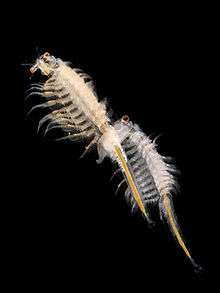Sea-Monkeys
|
| |
| Other names | Instant Life |
|---|---|
| Type | Novelty aquarium pet |
| Inventor | Harold von Braunhut |
| Country | United States |
| Availability | 1957–present |
Sea-Monkeys are a hybrid version of brine shrimp—a group of crustaceans that undergo cryptobiosis. Sea Monkeys are scientifically classified as Artemia NYOS[1], while brine shrimp are classified as Artemia salina. Sea Monkeys are sold in hatching kits as novelty aquarium pets. Developed in the United States in 1957, at this point being just part of the Artemia salina species[2], by Harold von Braunhut, the product was heavily marketed, especially in comic books, and remains a presence in popular culture.[3]
History
Ant farms had been popularized in 1956 by Milton Levine.[4] Harold von Braunhut invented a brine-shrimp-based product the next year, 1957.[4] Von Braunhut collaborated with marine biologist Dr. Anthony D'Agostino to develop the proper mix of nutrients and chemicals in dry form that could be added to plain tap water to create an accommodating habitat for the shrimp to thrive. Von Braunhut was granted a patent for this process on July 4, 1972.[5]
They were initially called "Instant Life" and sold for $0.49,[6] but von Braunhut changed the name to "Sea-Monkeys" in 1962. The new name was based on the supposed resemblance of the animals' tails to those of monkeys, and their salt-water habitat.[7]
Sea-Monkeys were intensely marketed in comic books throughout the 1960s and early 1970s[7] using illustrations by the comic-book illustrator Joe Orlando. These showed humanoid animals that bear no resemblance to the crustaceans.[8] Many purchasers were disappointed by the dissimilarity and by the short lifespan of the animals.[7] Von Braunhut is quoted as stating: "I think I bought something like 3.2 million pages of comic book advertising a year. It worked beautifully."[7]
Use
A colony is started by adding the contents of a packet labelled "Water Purifier" to a tank of water. This packet contains salt, water conditioner, and some brine shrimp eggs. After 24 hours, this is augmented with the contents of a packet labelled "Instant Life Eggs", containing more eggs, yeast, borax, soda, salt, some food and sometimes a dye.[8] Shortly thereafter, Sea-Monkeys hatch from the eggs that were in the "Water Purifier" packet. "Growth Food" containing yeast and spirulina is then added every few days. The best temperature for hatching is 24–27 °C (75–81 °F)[8]
Biology

The animals sold as Sea-Monkeys are an artificial breed known as Artemia NYOS (New York Ocean Science), formed by hybridising different species of Artemia.[7] They live longer and grow bigger than ordinary brine shrimp.[6] They undergo cryptobiosis or anhydrobiosis, a condition of apparent lifelessness which allows them to survive the desiccation of the temporary pools in which they live.[4]
Astronaut John Glenn took Sea-Monkeys into space on October 29, 1998, aboard Space Shuttle Discovery during mission STS-95. After nine days in space, they were returned to Earth, and hatched eight weeks later apparently unaffected by their travels.[8] However, earlier experiments on Apollo 16 and Apollo 17, where the eggs (along with other biological systems in a state of rest, such as spores, seeds and cysts) traveled to the Moon and back and were exposed to significant cosmic rays, observed a high sensitivity to cosmic radiation in the Artemia salina eggs; only 10% of the embryos which were induced to develop from eggs survived to adulthood. The most common mutations found during the developmental stages of the radiated eggs were deformations of the abdomen or deformations on the swimming appendages and naupliar eye of the nauplius.[9]
See also
- The Amazing Live Sea Monkeys
- "Simpsons Already Did It", a South Park episode that prominently features a parody of Sea-Monkeys called Sea People
- Triops
- Mexican jumping bean
References
- ↑ "Official Sea Monkeys Website". sea-monkeys.com. </ref https://www.sea-monkeys.com/about-the-sea-monkeys/
- ↑ "Official Sea Monkeys Website Cite". sea-monkeys.com. </ref https://www.sea-monkeys.com/about-the-sea-monkeys/
- ↑ Hitt, Jack (April 15, 2016). "The Battle Over the Sea-Monkey Fortune". The New York Times. Retrieved April 16, 2016.
- 1 2 3 May Berenbaum (2000). "Sea monkey see, sea monkey do". Buzzwords: a Scientist Muses on Sex, Bugs, and Rock 'n' Roll. Joseph Henry Press. pp. 45–49. ISBN 978-0-309-06835-2.
- ↑ Coopee, Todd. "Sea-Monkeys". ToyTales.ca.
- 1 2 Walsh, Walsh. "Official Sea Monkeys Website Cite". sea-monkeys.com. </ref https://www.sea-monkeys.com/about-the-sea-monkeys/
- 1 2 3 4 5 Tim Walsh (2005). "Ant Farm and Sea-Monkeys". Timeless Toys: Classic Toys and the Playmakers who Created Them. Andrews McMeel Publishing. pp. 124–129. ISBN 978-0-7407-5571-2.
- 1 2 3 4 Sharon M. Scott (2010). "Sea-Monkeys". Toys and American Culture: an Encyclopedia. ABC-CLIO. pp. 282–284. ISBN 978-0-313-34798-6.
- ↑ H. Bücker & G. Horneck (1975). "The biological effectiveness of HZE-particles of cosmic radiation studied in the Apollo 16 and 17 Biostack experiments". Acta Astronautica. 2 (3–4): 247–264. doi:10.1016/0094-5765(75)90095-8.